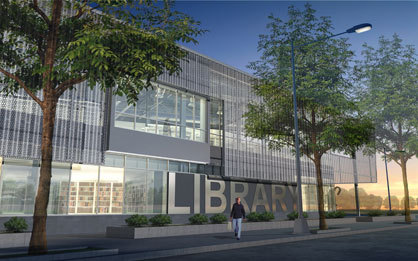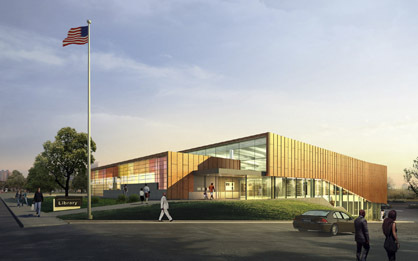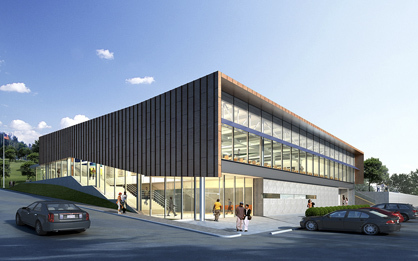Peter Cook: On Lines and Shadows
Texto por David Sokol
Washington, DC, Estados Unidos
05.08.09
Peter Cook is a Washington, DC–based principal of Davis Brody Bond Aedas
I am riffing off the term “unsung” with architect Peter Cook. “I feel very appreciated professionally and personally,” responds this principal at the New York–based firm Davis Brody Bond Aedas. But, he says of the unsung concept, “It’s not so much about being unknown than it is about operating in the shadows. And that, to me, is the parallel between me and my great-grand uncle.”
That great-grand uncle was Julian F. Abele, one of the first and most prominent black architects in American history. Born in 1881, Abele excelled as an architect of whatever skin color: graduating from the University of Pennsylvania, studying at the École des Beaux-Arts, and then becoming chief designer of the renowned Philadelphia firm Horace Trumbauer. A Beaux Arts adherent and committed Francophile, Abele championed American revival architecture in a series of high-profile commissions that included the Free Library of Philadelphia, Harvard’s Widener Library, and the original campus of Duke University. But for the most part, he did so with Trumbauer’s imprimatur. “He was a shy and retiring person, he didn’t like being in front,” Cook says.
Born 13 years after Abele’s death, Cook is no Francophile. Indeed, his professional perch, 1975 AIA Architecture Firm Award winner Davis Brody Bond, is distinguished by decades of modernist designs that range from competent to startling. Cook cites his grandfather Julian Abele Cook as the closer relative who influenced his decision to practice this kind of architecture. “Absolutely, no question about it,” Cook says, recalling childhood days spent in his grandfather’s basement study, absorbing jazz 78s and myriad tomes on modernism. Abele Cook looked forward, thanks to his lifelong employment at Howard University as building coordinator for Albert Cassell.
Yet practicing architecture wasn’t inevitable for Cook. Taking the advice of a family friend, he enrolled in the visual and environmental studies program at Harvard College and excelled in campus radio. Nor was subscribing to a certain brand of contemporary architecture a given. As a graduate student at Columbia between 1986 and 1989, for example, the school was in the throes of change as James Polshek passed the reins to Bernard Tschumi. No one dean molded the formative designer.
Some experiences did leave indelible impressions. Cook notes once attending a Herman Herzberger lecture, recalling that “all of the pictures of his work had people in them. One of the things I never try to forget, and maybe it’s a cliché, is that architecture ultimately comes down to the people who occupy the space.” Cook also remembers visiting a Harvard friend who explained how a Walter Gropius–designed dorm building revered by the architecture students was reviled by everyone else (poor circulation). “Somehow in architecture we tend to skip over the minor inconveniences that folks have suffered through. That’s why, when I had the opportunity to join Davis Brody Bond all those years ago, I jumped. I think this firm never loses sight of the fact that architecture is artwork performed in a social setting.”
That year was 1994. But it hasn’t been all smooth sailing since. After moving to Washington, DC, to raise a family, Cook made a break from the firm. He first practiced solo, and then, deciding that “I didn’t want small jobs to define who I was as an architect,” worked as principal of KGP Design Studio between 2000 and 2005. With projects ranging from a master plan in Manilla to a pedestrian bridge dedicated to a human rights activist, KGP offered Cook rock-star opportunity. And when firm namesake Max Bond approached Cook about rekindling the working relationship, Cook appropriately expressed some concern about returning to New York to get lost in the crowd. So the two soon agreed on the best of both worlds: Cook would open a Washington, DC, studio and expand Davis Brody Bond’s presence.
Currently overseeing a handful of staffers, Cook is not exactly a 21st-century Abele, veiled in shadows or hiding behind a computer screen. But he refuses to claim a signature, and he recognizes the exigencies of building today. “We have this romance about architecture appearing magically, but unless you want to do paper architecture, it’s collaborative,” he says. “Your designs are always being discussed or debated by any number of people.”
In fact, Cook embraces them. He notes that he prefers the larger corporate office to his KGP stint, calling it “a more collegial environment where you can leverage everybody’s experience and expertise.” He also cites projects in which more input is better. For the Benning Neighborhood Library and Watha T. Daniel/Shaw Neighborhood Library in Washington, DC, David Brody Bond looked beyond office walls, coordinating a series of community meetings in which residents devised programming that upends the traditional obligations of a book repository. “These two libraries are located in underserved neighborhoods, and residents justifiably had reason to question authority,” Cook explains. “We’ve tried very hard to ensure that their voices are listened to. It can’t be design by committee, but that should not suggest we can ignore these voices.”
A project further down the road, the modernization and expansion of the South African Embassy on Massachusetts Avenue, promises to rethink a different set of traditions. Only since the completion of the Finnish Embassy have there been alternatives to the capital city’s stodgy landscape of brick-and-stone historicism, Cook posits, and even though ye olde architecture still rules DC, “I think design sensibilities here have really changed for the better in the last 15 years.”
In bestowing the assignment to take on the South African Embassy, which currently comprises a 1936 Dutch Colonial building and a 1963 mimic, former ambassador Barbara Masekela said of the extant buildings, “’Those are great examples of the old South Africa, but unless one has been sleeping under a rock we all know there’s a new South Africa. We need to accept the old but make a statement.” Symbolizing the nation’s economic reliance on its mineral deposits, Cook has schemed a contrasting essay in materiality. “I think it’s a great opportunity for us to be able to push the envelope a little bit,” he says. Although in another, characteristic, breath, he adds, “I’m not seeking to be controversial for the sake of pushing the envelope. I think, I hope, I don’t have an ego that’s outsize for my talent.”
Next time: The Unsung American road trip continues. (This time, I mean it.) We take up again in Indiana.











